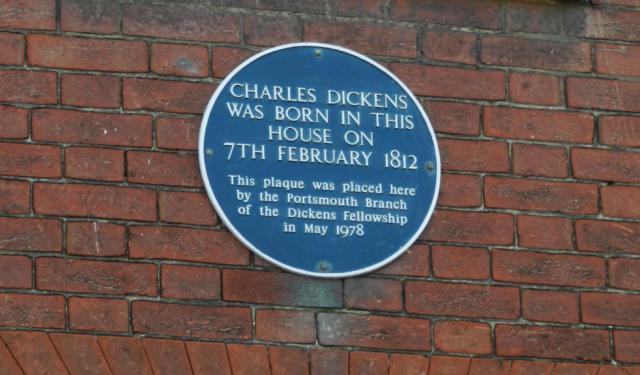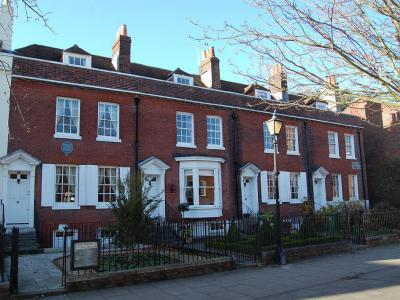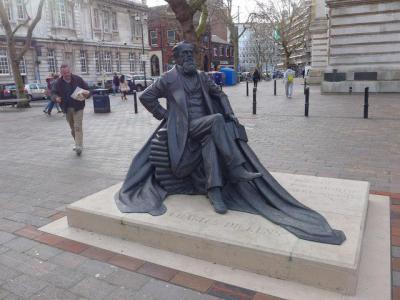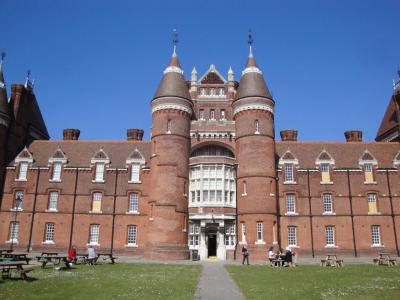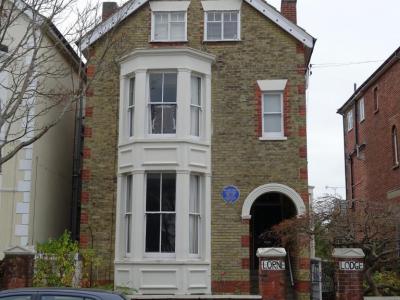Famous English Writers Walking Tour (Self Guided), Portsmouth
Jane Austen was born in 1775 in Steventon, North Hampshire. In her day, Portsmouth was a rough-edged seaport filled with people she considered "underbred." Nevertheless, she often traveled to Portsmouth to visit her brothers Francis and Charles, stationed there with the Royal Navy. Austen included Royal Naval characters in her novels, Persuasion and Mansfield Park.
Charles Dickens was born in Portsmouth in February 1812. His birthplace, now a museum, was on the present-day Old Commercial Road. His father, John, worked in the Dockyard in the Navy Pay Office. John was notoriously improvident. He served as a basis for Charles' characters, Mr. Micawber and Mr. Dorrit. Dickens modeled many of his characters on the local people of Portsmouth.
Sir Arthur Conan Doyle wrote his first two Sherlock Holmes stories while residing in Portsmouth. A new doctor, he arrived in 1882 and opened a practice at 1 Bush Villas, Elm Grove, Southsea. A Study in Scarlet and The Sign of the Four were written here.
Rudyard Kipling grew up from the age of five through eleven at Lorne Lodge on Campbell Road, a suburb of Southsea, Portsmouth. He and his sister were boarded at the home of a Captain and Mrs. Holloway. Holloway was the basis of the fisherman in Captains Courageous.
H.G Wells, master of telling a horrible story in an ordinary setting, worked as an apprentice at Hyde's Drapery Emporium at 9 Kings Road in Southsea. He was fifteen and may have crossed paths with Arthur Conan Doyle. Kings Road is an extension of Elm Grove, Doyle's street.
Portsmouth has also been the stomping ground for Susanna Rawson, Sir Walter Besant, Christopher Hitchins, George Meredith, Graham Hurley, Nevil Shute, and Maggie Sawkins. And the list goes on.
Charles Dickens was born in Portsmouth in February 1812. His birthplace, now a museum, was on the present-day Old Commercial Road. His father, John, worked in the Dockyard in the Navy Pay Office. John was notoriously improvident. He served as a basis for Charles' characters, Mr. Micawber and Mr. Dorrit. Dickens modeled many of his characters on the local people of Portsmouth.
Sir Arthur Conan Doyle wrote his first two Sherlock Holmes stories while residing in Portsmouth. A new doctor, he arrived in 1882 and opened a practice at 1 Bush Villas, Elm Grove, Southsea. A Study in Scarlet and The Sign of the Four were written here.
Rudyard Kipling grew up from the age of five through eleven at Lorne Lodge on Campbell Road, a suburb of Southsea, Portsmouth. He and his sister were boarded at the home of a Captain and Mrs. Holloway. Holloway was the basis of the fisherman in Captains Courageous.
H.G Wells, master of telling a horrible story in an ordinary setting, worked as an apprentice at Hyde's Drapery Emporium at 9 Kings Road in Southsea. He was fifteen and may have crossed paths with Arthur Conan Doyle. Kings Road is an extension of Elm Grove, Doyle's street.
Portsmouth has also been the stomping ground for Susanna Rawson, Sir Walter Besant, Christopher Hitchins, George Meredith, Graham Hurley, Nevil Shute, and Maggie Sawkins. And the list goes on.
How it works: Download the app "GPSmyCity: Walks in 1K+ Cities" from Apple App Store or Google Play Store to your mobile phone or tablet. The app turns your mobile device into a personal tour guide and its built-in GPS navigation functions guide you from one tour stop to next. The app works offline, so no data plan is needed when traveling abroad.
Famous English Writers Walking Tour Map
Guide Name: Famous English Writers Walking Tour
Guide Location: England » Portsmouth (See other walking tours in Portsmouth)
Guide Type: Self-guided Walking Tour (Sightseeing)
# of Attractions: 5
Tour Duration: 2 Hour(s)
Travel Distance: 3.7 Km or 2.3 Miles
Author: IreneB
Sight(s) Featured in This Guide:
Guide Location: England » Portsmouth (See other walking tours in Portsmouth)
Guide Type: Self-guided Walking Tour (Sightseeing)
# of Attractions: 5
Tour Duration: 2 Hour(s)
Travel Distance: 3.7 Km or 2.3 Miles
Author: IreneB
Sight(s) Featured in This Guide:
- Charles Dickens' Birthplace Museum
- Charles Dickens Statue
- Portsmouth Museum and Art Gallery
- Arthur Conan Doyle Residence and Medical Practice
- Rudyard Kipling's Childhood Residence
1) Charles Dickens' Birthplace Museum
The Charles Dickens’ Birthplace Museum stands on the exact site where the celebrated Victorian author was born on 7 February 1812. This modest yet elegant three-storey Georgian townhouse-previously known as 1 or possibly 13 Mile End Terrace-has been carefully preserved to reflect the Regency-style interior typical of Dickens’s early years. It was here that his parents, John and Elizabeth Dickens, originally from London, settled in 1809 while John worked as a clerk at the Navy Pay Office in the Portsmouth Dockyard. The family’s stay was brief, however, as mounting debts forced them to relocate frequently.
Today, the museum immerses visitors in the domestic setting of Dickens’s childhood. Three rooms-the parlour, dining room, and the bedroom where he was born-have been authentically furnished to match early 19th-century tastes. The Exhibition Room further explores Dickens’s legacy, displaying personal belongings such as his snuffbox, paper-knife, inkwell, and the sofa on which he died in 1870. These objects, alongside period glassware, ceramics, and family photographs, offer a window into the material culture that shaped the future author’s worldview.
Although Charles Dickens left Portsmouth in infancy, he later returned for research and found inspiration in its people and settings-reflected in novels like Nicholas Nickleby, which includes the theme of a father burdened by debt. Today, the museum not only honours his literary legacy but also stages events such as costumed reenactments live readings by the Dickens Fellowship.
Today, the museum immerses visitors in the domestic setting of Dickens’s childhood. Three rooms-the parlour, dining room, and the bedroom where he was born-have been authentically furnished to match early 19th-century tastes. The Exhibition Room further explores Dickens’s legacy, displaying personal belongings such as his snuffbox, paper-knife, inkwell, and the sofa on which he died in 1870. These objects, alongside period glassware, ceramics, and family photographs, offer a window into the material culture that shaped the future author’s worldview.
Although Charles Dickens left Portsmouth in infancy, he later returned for research and found inspiration in its people and settings-reflected in novels like Nicholas Nickleby, which includes the theme of a father burdened by debt. Today, the museum not only honours his literary legacy but also stages events such as costumed reenactments live readings by the Dickens Fellowship.
2) Charles Dickens Statue
In 2014, two hundred years after his death, Charles Dickens' statue was unveiled in Guildhall Square. Dickens was born in Portsmouth, but what he might think of the statue is anyone's guess. He specifically stated the only memorial he might crave is his readership. More than 100 invited guests, including 40 members of the Dickens family, attended the ceremony.
The bronze statue is the first of Charles Dickens in England. Its unveiling took place on his birthday, February 7. The image is of the author, book in hand, reclining, and with a stack of books by his side. He seems to be staring into space, perhaps imagining his characters.
The statue was created by sculptor Martin Jennings. Jennings said of the pose, "I wanted to suggest he is about to jump to his feet and begin one of the readings of Oliver Twist that had people weeping and fainting in the aisles." Whether Jennings succeeded in his effort to portray this image is debatable, but the Dickens family approved.
The bronze statue is the first of Charles Dickens in England. Its unveiling took place on his birthday, February 7. The image is of the author, book in hand, reclining, and with a stack of books by his side. He seems to be staring into space, perhaps imagining his characters.
The statue was created by sculptor Martin Jennings. Jennings said of the pose, "I wanted to suggest he is about to jump to his feet and begin one of the readings of Oliver Twist that had people weeping and fainting in the aisles." Whether Jennings succeeded in his effort to portray this image is debatable, but the Dickens family approved.
3) Portsmouth Museum and Art Gallery
The Portsmouth Museum is located on Museum Road in Portsmouth. It is one of the six museums operated by the Portsmouth City Council. The building, dating from the 1890s, was once part of the Clarence and Victoria Barracks compound. Except for the museum block, the barracks were demolished in 1972.
The museum building is of red brick, with tile roofing. There are four stories. On each side of the central bays are towers with pointed spires. Fine and decorative arts are displayed in the museum. Exhibits are a melange of works from the permanent collections. Some selections are related to Portsmouth from the 17th century until the 1950s.
Richard Lancelyn Green, the foremost scholar of Arthur Conan Doyle and his creature, Sherlock Holmes, has his famed Collection of Doyle's oeuvres at the museum. It is the most comprehensive of its kind in the world. There are books, letters, films, and television memorabilia.
Some galleries examine everyday life in Portsmouth, Pompey, and Portsmouth at play. The scenes of rooms are typical of certain people at different times in history. The Football in the City exhibit has memorabilia from the FA Cup Finals.
The museum building is of red brick, with tile roofing. There are four stories. On each side of the central bays are towers with pointed spires. Fine and decorative arts are displayed in the museum. Exhibits are a melange of works from the permanent collections. Some selections are related to Portsmouth from the 17th century until the 1950s.
Richard Lancelyn Green, the foremost scholar of Arthur Conan Doyle and his creature, Sherlock Holmes, has his famed Collection of Doyle's oeuvres at the museum. It is the most comprehensive of its kind in the world. There are books, letters, films, and television memorabilia.
Some galleries examine everyday life in Portsmouth, Pompey, and Portsmouth at play. The scenes of rooms are typical of certain people at different times in history. The Football in the City exhibit has memorabilia from the FA Cup Finals.
4) Arthur Conan Doyle Residence and Medical Practice
The young struggling Doctor Doyle lived and kept his general practice at Bush Villas in Southsea, Portsmouth. He arrived here in 1882. He moved to London in 1890 to practice ophthalmology. One photo shows him on a visit to Southsea in 1911. He stands in the front doorway next to a lingerie shop. There appears to be light rain.
The original building in the photograph no more exists. It was flattened in a World War II bombing raid. Now, the space is occupied by a block of apartments. On the brick wall in front are two blue plaques commemorating Doyle's residence and his first two Sherlock Holmes stories written here.
Doyle took up the study of medicine in Edinburgh, Scotland. After serving two voyages as a ship's doctor, he entered a disastrous partnership with George Budd, a classmate. This partnership fell apart, and Doyle, strapped for cash to set up his own practice, moved to Portsmouth. There were few patients, so he had time to write.
The character of Sherlock Holmes is based on Dr. Joseph Bell, Doyle's Professor of Surgery in Edinburgh. The doctor showed incredible skills in reasoning and observation. Photos of mustachioed Doyle show a resemblance to Nigel Bruce, the actor who played Doctor Watson, opposite Basil Rathbone as Sherlock Holmes in the film.
The original building in the photograph no more exists. It was flattened in a World War II bombing raid. Now, the space is occupied by a block of apartments. On the brick wall in front are two blue plaques commemorating Doyle's residence and his first two Sherlock Holmes stories written here.
Doyle took up the study of medicine in Edinburgh, Scotland. After serving two voyages as a ship's doctor, he entered a disastrous partnership with George Budd, a classmate. This partnership fell apart, and Doyle, strapped for cash to set up his own practice, moved to Portsmouth. There were few patients, so he had time to write.
The character of Sherlock Holmes is based on Dr. Joseph Bell, Doyle's Professor of Surgery in Edinburgh. The doctor showed incredible skills in reasoning and observation. Photos of mustachioed Doyle show a resemblance to Nigel Bruce, the actor who played Doctor Watson, opposite Basil Rathbone as Sherlock Holmes in the film.
5) Rudyard Kipling's Childhood Residence
"My first impression," Kipling wrote in his autobiography, "is of daybreak, light and color and golden and purple fruits." Kipling was born in Bombay (Mumbai), India, in 1865. His father, John Lockwood Kipling, was an architect and artist. His mother was Alice MacDonald, a familiar of Sir Edward Burne-Jones and the Pre-Raphaelites, a group of English painters, poets, and art critics.
In 1871, he and his sister, Beatrice, called "Trix," were sent back to England. Rudyard and Beatrice were placed in the care of Mrs. Holloway, a widow of a merchant navy captain. The Kipling children later called the place the "House of Desolation."
It was an early childhood in hell, apparently. Rudyard recalled being bullied and beaten by the sadistic widow Holloway and her nasty son. He reports being "well beaten" and sent to school in the streets of Southsea with a card saying "LIAR" attached to his shoulders.
He did have some happy intervals at the home of his aunt, Lady Burne-Jones. The Burne-Jones' house, "the Grange," was frequented by artists and creative friends of Sir Edward. Soon "the delicious dream would end," Kipling wrote, and they would return to the "House of Desolation."
Kipling attended the United Services College in Devon in 1878. In 1882, at 18 years old, he left England for India to reunite with his family. In India, his career as a journalist would begin.
In 1871, he and his sister, Beatrice, called "Trix," were sent back to England. Rudyard and Beatrice were placed in the care of Mrs. Holloway, a widow of a merchant navy captain. The Kipling children later called the place the "House of Desolation."
It was an early childhood in hell, apparently. Rudyard recalled being bullied and beaten by the sadistic widow Holloway and her nasty son. He reports being "well beaten" and sent to school in the streets of Southsea with a card saying "LIAR" attached to his shoulders.
He did have some happy intervals at the home of his aunt, Lady Burne-Jones. The Burne-Jones' house, "the Grange," was frequented by artists and creative friends of Sir Edward. Soon "the delicious dream would end," Kipling wrote, and they would return to the "House of Desolation."
Kipling attended the United Services College in Devon in 1878. In 1882, at 18 years old, he left England for India to reunite with his family. In India, his career as a journalist would begin.
Walking Tours in Portsmouth, England
Create Your Own Walk in Portsmouth
Creating your own self-guided walk in Portsmouth is easy and fun. Choose the city attractions that you want to see and a walk route map will be created just for you. You can even set your hotel as the start point of the walk.
Historical Dockyard Tour
The naval theme has always been dominant for Portsmouth. Most of the city's historic events are in one way or another associated with its seaside location. Portsmouth's Historical Dockyard is the area that offers a glimpse into the city's maritime past.
The very first notable landmark here is Victory Gate, the dockyard's main entrance. Inside, visitors will find HMS... view more
Tour Duration: 1 Hour(s)
Travel Distance: 0.4 Km or 0.2 Miles
The very first notable landmark here is Victory Gate, the dockyard's main entrance. Inside, visitors will find HMS... view more
Tour Duration: 1 Hour(s)
Travel Distance: 0.4 Km or 0.2 Miles
Portsmouth Introduction Walking Tour
The Anglo-Saxon Chronicle claims a warrior named Port and his two sons killed a noble Briton in Portsmouth in 501 AD. Winston Churchill, in his "A History of the English-Speaking Peoples," wrote that Port was a pirate who founded Portsmouth in the same year.
King AEthelwulf sent a force to drive off Viking raiders in Portsmouth in the 9th century. The Danes loved Portsmouth, but they... view more
Tour Duration: 2 Hour(s)
Travel Distance: 4.2 Km or 2.6 Miles
King AEthelwulf sent a force to drive off Viking raiders in Portsmouth in the 9th century. The Danes loved Portsmouth, but they... view more
Tour Duration: 2 Hour(s)
Travel Distance: 4.2 Km or 2.6 Miles
The Most Popular Cities
/ view all
